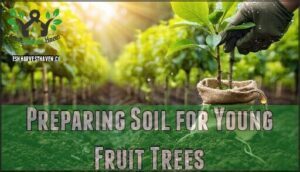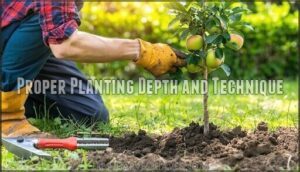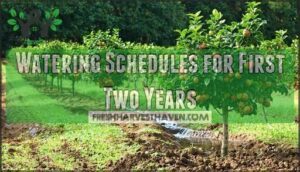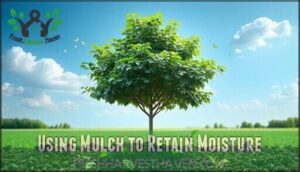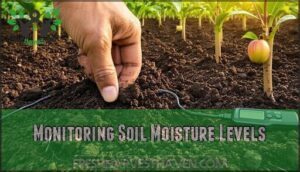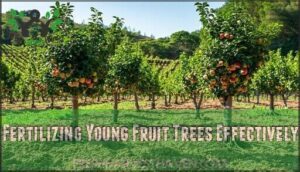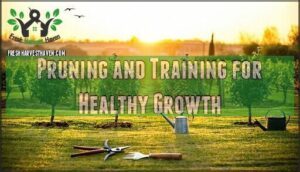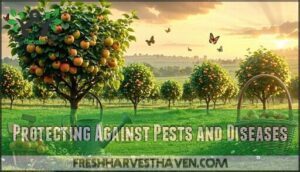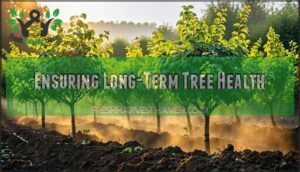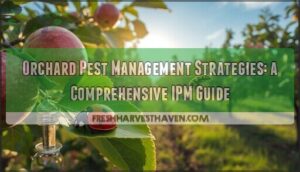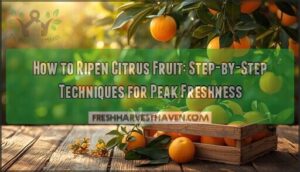This site is supported by our readers. We may earn a commission, at no cost to you, if you purchase through links.
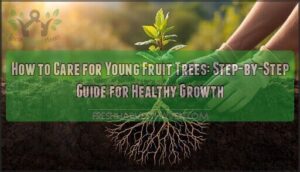
The difference between a thriving orchard and years of disappointment often comes down to understanding what your tree needs during those vulnerable early seasons—when its root system is still establishing and every decision shapes its future productivity.
Getting the fundamentals right from day one sets you up for decades of reliable harvests, transforming careful attention now into baskets of fresh fruit later.
Table Of Contents
Key Takeaways
- Most young fruit trees fail from overwatering and improper planting depth rather than neglect, making correct initial setup more critical than ongoing intervention for long-term success.
- The first two years demand weekly deep watering (1-2 inches), strategic pruning focused on structure over removal, and fruit thinning to redirect energy toward root establishment instead of premature production.
- Soil preparation with 2-4 inches of compost mixed into the top 12 inches, combined with proper graft union positioning 2-3 inches above ground, creates the foundation that determines decades of harvest productivity.
- Organic pest control through beneficial insects and companion planting, paired with early spring fertilization using balanced formulas, builds resilient trees that withstand environmental stress without chemical dependency.
Preparing Soil for Young Fruit Trees
You won’t grow healthy fruit trees without starting with the right foundation. The soil you prepare today determines whether your young trees thrive or struggle for years to come.
Here’s what you need to focus on to give your trees the best possible start.
Adding Organic Matter and Compost
Think of compost as the foundation meal your young fruit tree craves—it’s packed with slow-release nutrients that feed both roots and the soil microbes working overtime to help your tree thrive. When you’re adding organic material, focus on these three essentials:
- Mix 2–4 inches of compost into the top 12 inches of soil before planting
- Layer mulch techniques around the base to boost humus formation
- Reapply organic fertilizers annually to maintain soil health and fertility
These soil amendments directly improve soil quality, ensuring your tree gets what it needs.
Selecting The Right Planting Site
Once you’ve enriched your soil with compost, your next move is finding a spot where your tree won’t just survive—it’ll actually flourish. Conduct a thorough soil assessment to verify soil pH sits between 6.0 and 7.0—critical for soil health and nutrient uptake.
Factor in climate conditions and sunshine requirements; your tree needs at least six hours of direct sunlight daily. Plan spacing carefully to avoid competition and guarantee proper air circulation around each tree.
Raised Beds Vs. In-Ground Planting
After you’ve locked down the perfect site, you’ll need to decide whether your tree does better starting life in a raised bed or settled straight into the ground.
Raised beds offer enhanced bed soil quality and in-ground drainage control, especially in compacted or clay-heavy soils. Bed height considerations matter—12 to 18 inches works well for young fruit trees.
In-ground planting suits sites with excellent native soil quality and natural soil erosion control.
Planting and Watering Best Practices
Getting your young fruit tree into the ground correctly sets the foundation for years of healthy growth and abundant harvests. The way you plant and water during those critical first two years determines whether your tree thrives or struggles.
Let’s walk through the essential practices that’ll give your tree the best possible start.
Proper Planting Depth and Technique
Getting the planting depth right isn’t just a detail—it’s the foundation that determines whether your young fruit tree will thrive or struggle for years to come.
Follow these steps for proper tree planting and establishment:
- Dig a hole twice as wide as the root ball but only as deep as the root depth
- Use planting tools to break up compacted edges and prevent soil compaction
- Set the tree so the graft union sits 2–3 inches above ground level
- Check tree alignment from multiple angles before backfilling
Proper hole preparation ensures roots spread freely without circling or suffocating.
Watering Schedules for First Two Years
Your young fruit tree won’t make it on wishful thinking alone—consistent watering during its first two years is what separates thriving specimens from stunted disappointments. Aim for 1–2 inches of water weekly during the growing season, adjusting based on soil moisture levels and weather conditions.
Deep irrigation promotes strong root development, while shallow watering encourages surface roots vulnerable to drought. Monitor your soil—if it’s dry 2–3 inches down, it’s time to water. Smart irrigation timing and drought management techniques help you balance water conservation with your young fruit trees’ critical establishment needs.
| Tree Age | Watering Frequency | Water Depth per Session |
|---|---|---|
| Year 1 | Every 2–3 days in heat/drought | 2.5–3 gallons |
| Year 2 | Twice weekly (normal conditions) | 3–4 gallons |
| Both Years | Weekly during cool/wet periods | 1–2 gallons |
Using Mulch to Retain Moisture
Spread a 2–4 inch layer of organic mulch around your tree’s base, and you’ll lock in moisture while cutting your watering workload nearly in half. Wood chips, shredded bark, or compost regulate soil temperature, suppress weeds, and improve soil health as they decompose. Keep mulch 3–6 inches away from the trunk to prevent rot and pest problems.
Monitoring Soil Moisture Levels
Check soil moisture with your finger pressed two inches down—if it feels dry at that depth, it’s time to water. A moisture meter offers more precision, while soil sensors can automate your irrigation scheduling.
These watering techniques improve soil and water management, ensuring healthy drainage systems and ideal soil quality without overwatering or stressing roots.
Fertilizing Young Fruit Trees Effectively
Feeding your young fruit trees the right nutrients at the right time makes all the difference between lackluster growth and a thriving orchard. You’ll need to understand which fertilizers work best, when to apply them, and how to adjust your approach as your trees mature.
Let’s break down the essentials of fertilizing young fruit trees so you can give them exactly what they need.
Choosing Balanced Fertilizers (10-10-10)
A balanced fertilizer like 10-10-10 acts as a complete meal for your young fruit tree, delivering equal parts nitrogen for leafy growth, phosphorus for strong roots, and potassium for disease resistance and fruit development. This nutrient balance promotes plant nutrition without overwhelming immature root systems.
Always test your soil pH first—fertilization works best when acidity sits between 6.0 and 7.0, allowing micronutrients to reach roots efficiently during critical fertilization timing windows.
Organic Vs. Synthetic Fertilizers
Think of organic and synthetic fertilizers as slow-cooked stew versus fast food for your tree—each has its place. Organic matter feeds soil microbes that gradually release nutrients, building lasting soil health and supporting nutrient uptake. Synthetics deliver instant plant nutrition but skip the soil-building benefits that strengthen eco balance over time.
Key differences you’ll notice:
- Organic farming inputs like compost improve soil structure and water retention while releasing nutrients slowly
- Synthetic fertilizers provide precise, rapid nutrient availability but may bypass beneficial soil microbes
- Organic fertilization improves long-term fertility and reduces environmental impact, though application rates vary
- Blending both approaches often produces best results for young trees, balancing immediate needs with sustained soil health and nutrition
Research shows organic fertilizers can increase yields dramatically—up to 138% in some cases—while synthetic options offer predictable, controlled feeding. Understanding the soil health benefits is vital for making informed decisions about fertilization.
Timing and Application Rates
Getting the timing right can mean the difference between a tree that thrives and one that merely survives. Apply fertilizer in early spring as buds swell, matching nutrient applications to growth stages for maximum uptake.
Coordinate fertilization and nutrition with watering rates—never fertilize dry soil, as it burns tender roots.
| Growth Stage | Fertilization Schedule |
|---|---|
| First Year | Light application (¼ cup) monthly, April–July |
| Second Year | ½ cup balanced fertilizer every 6–8 weeks |
| Established Trees | Annual spring feeding with soil quality assessment |
| Dormant Period | No fertilization; focus on pruning timings and watering techniques |
Adjusting Fertilizer Based on Growth
Your tree’s leaves, shoots, and overall vigor tell you everything you need to know about whether you’re feeding it too much, too little, or just right. Watch for pale leaves signaling nutrient deficiencies—boost fertilization timing and ratios accordingly.
Stunted growth stages or excessive shoot production mean it’s time for soil testing to assess soil quality and adjust fertilizer ratios, optimizing nutrient uptake.
Proper fruit tree care and maintenance means responding to what tree growth reveals about fertilization and nutrition needs.
Pruning and Training for Healthy Growth
Pruning and training your young fruit trees during their early years sets the foundation for strong structure and abundant harvests down the road. The timing, technique, and approach you use will directly impact how well your trees produce fruit and withstand environmental stress.
Let’s walk through the essential pruning practices that’ll help your trees thrive from their first season onward.
When to Prune Different Fruit Trees
Timing makes all the difference for pruning—catch your fruit trees at the wrong moment, and you’ll sacrifice both growth and next season’s harvest. Most fruit trees thrive with late winter or early spring pruning during dormancy periods, when they’re resting before budbreak.
Stone fruits like peaches prefer later dormant-season cuts, while apples and pears tolerate earlier intervention. Use sharp pruning tools to minimize stress and promote faster healing across all fruit tree types.
Shaping: Central Leader Vs. Vase Form
Once you’ve nailed the timing, you’ll need to choose between two foundational shapes that determine how your tree grows for years to come.
Central leader training creates a strong single trunk with horizontal branches—ideal for apples and pears—maximizing fruit yield through vertical structure.
Vase training opens the canopy with multiple main branches, perfect for stone fruits like peaches, improving air circulation and sun exposure for consistent fruit production.
First-Year Pruning Guidelines
After you’ve picked your training method, the first year demands a light but strategic hand—one that sets the shape without stunting growth.
Using sharp pruning tools during dormancy care, remove inward-growing branches and any crossing limbs that compete for space. Focus on tree shaping rather than aggressive branch removal—young fruit trees need foliage to build strength.
This foundational pruning establishes proper structure for long-term fruit tree maintenance and vigorous production.
Making Clean, Safe Cuts
Every cut you make becomes a potential entry point for disease, so precision matters more than speed. Use sharp cutting tools—dull blades tear bark and delay wound healing. Angle each cut at 45 degrees, just above an outward-facing bud, so water drains away cleanly.
These pruning techniques aren’t just about aesthetics; they’re safety precautions that protect your tree’s future. Proper pruning and training fruit trees means respecting the biology beneath the bark.
Protecting Against Pests and Diseases
Young fruit trees face threats from pests and diseases that can stunt growth or damage developing crops. Catching problems early and using the right prevention methods protects your investment and keeps trees thriving.
Let’s walk through practical ways to inspect, treat, and safeguard your young trees against common threats.
Regular Inspection Techniques
Think of inspecting your young fruit trees like checking your car’s dashboard—you wouldn’t wait for the warning light to start blinking before looking under the hood.
Walk around each tree weekly, scanning leaves for discoloration, holes, or unusual spots that signal pest activity or disease identification issues. Check the trunk for cracks or oozing sap, examine roots for exposure or rot, and note any stunted growth indicating nutrient deficiencies—these tree health checks catch problems early when they’re easiest to fix.
Organic Pest Control Methods
When aphids, caterpillars, or other pests show up uninvited, neem oil and diatomaceous earth become your first line of defense without reaching for harsh chemicals. These natural pest deterrents work through integrated pest management, disrupting pest life cycles while keeping your tree safe:
- Neem oil spray suffocates soft-bodied insects and interrupts feeding patterns
- Diatomaceous earth creates a barrier that dehydrates crawling pests on contact
- Insecticidal soap targets aphids and mites without harming the tree itself
- Horticultural oils smother overwintering eggs before they hatch in spring
Encouraging Beneficial Insects
Ladybugs, lacewings, and parasitic wasps won’t just wander into your fruit tree’s canopy by accident—you’ve got to roll out the welcome mat with the right flowering plants nearby. Plant nectar-rich flowers like yarrow, alyssum, and marigolds within 10 feet of your trees to attract these beneficial bugs that naturally control pest populations.
You’re creating ecosystem balance through pollinator gardens that support natural pest control while drawing in bees for pollination—two birds, one stone.
Disease Prevention and Treatment
Protect your young fruit trees before fungal disease strikes—prevention beats scrambling for a cure every time. Start by selecting disease-resistant varieties like Crimson Crisp or Enterprise, which slash fireblight infections by up to 60%.
Apply organic sprays like sulfur and copper during dormant seasons to cut apple scab and powdery mildew by 80%. For biological fungicides, Bacillus subtilis products reduce brown rot by roughly 50%, supporting tree health and wellness through natural bacterial control and disease management.
Maintaining healthy trees also involves understanding tree root systems to ensure proper growth.
Ensuring Long-Term Tree Health
Your young fruit tree won’t thrive on autopilot—long-term health depends on consistent attention and smart planning. The early years set the stage, but sustained vigor requires you to address four key areas that work together like gears in a well-oiled machine.
Here’s what you need to focus on as your tree matures.
Ongoing Maintenance and Monitoring
Your young fruit tree won’t thrive on autopilot—consistent monitoring and seasonal adjustments separate productive orchards from struggling saplings. Perform tree health checks weekly during the growing season, tracking growth patterns and noting any stress signals.
Monitor soil quality and water balance through regular inspections, adjusting your care routine as conditions shift.
Stay vigilant with pest surveillance and maintain your pruning schedule to support vigorous tree health and wellness.
Supporting Biodiversity Around Trees
A thriving fruit tree relies on more than water and fertilizer—the ecosystem around it creates a natural defense system that reduces pests, improves pollination, and builds soil health over time.
Plant nectar-rich flowers nearby to attract beneficial insects like ladybugs and lacewings, which manage pest control naturally.
This approach bolsters your tree microbiome, supports pollinator gardens, and maintains ecological balance—all cornerstones of sustainable gardening that improve soil quality and orchard management through biodiversity conservation and ecosystem services.
Climate and Sunlight Considerations
Climate and sunlight aren’t afterthoughts—they’re the foundation for whether your young fruit trees thrive or struggle. Beyond biodiversity, matching your tree to its environment determines success. Consider these three factors:
- Sunlight Hours: Most fruit trees need at least six hours of direct sunshine daily for ideal tree growth.
- Temperature Zones: Select varieties adapted to your region’s heat stress patterns and chill requirements.
- Sunlight Exposure: Southern-facing sites optimize climate adaptation and minimize temperature-related setbacks.
Position trees where they’ll receive consistent sunshine throughout their growing season.
Planning for Fruit Production and Longevity
Once you’ve set the stage with sunlight and climate, the real payoff comes from planning how your trees will produce fruit year after year without burning out. Smart orchard establishment means spacing trees properly for air circulation and maximizing fruit yield without exhausting young fruit trees.
Balance annual harvest strategies with rest periods to maintain tree longevity and ecosystem balance—your garden planning today determines decades of fruit production ahead.
Frequently Asked Questions (FAQs)
What rootstock should I choose for my young fruit tree?
Rootstock selection acts as the foundation beneath the surface—it determines your young fruit tree’s hardiness, eventual size, and soil compatibility.
Choose dwarfing rootstocks for compact orchards or standard ones for vigorous growth, always matching the rootstock to your fruit variety and local climate conditions.
How do I protect trees from winter cold damage?
Wrap your young fruit tree trunks with white tree guards or burlap to prevent frost cracks and sunscald during winter. Apply a thick mulch layer around the base for root insulation, and consider windbreaks in exposed locations for added cold hardiness.
When can I expect my tree to produce fruit?
Most fruit trees take three to five years to bear fruit, though this timeline depends on the tree’s variety, rootstock, and how well you maintain it during the growth stages.
Should I thin fruit during the first few years?
Think of it like asking a marathon runner to compete while carrying weights—it drains energy they desperately need elsewhere. Remove all fruit during the first two years to redirect critical resources toward establishing strong roots and sturdy tree vigor rather than premature fruit production.
Remove all fruit the first two years—young trees need every ounce of energy for roots, not production
This practice, called fruit thinning, ensures healthier long-term fruit size, balanced crop load, and ideal harvest timing.
How do I prevent deer from damaging young trees?
Install physical barriers like tree guards or fencing around your young fruit trees to prevent deer damage. Use repellent plants such as lavender or strong-scented herbs nearby, and apply commercial deer deterrents regularly. These pest management strategies protect your investment while trees establish themselves.
Conclusion
Every decision you make in these early years ripples through decades of harvests—skip a single watering during a drought, and you might lose years of growth potential.
But when you care for young fruit trees with the precision and consistency outlined here, you’re building more than healthy branches. You’re establishing resilient root systems that withstand storms, intelligent canopy structures that optimize sunlight, and productive habits that transform your backyard into a reliable food source.
The time you invest now doesn’t just protect saplings—it guarantees abundance for generations.

